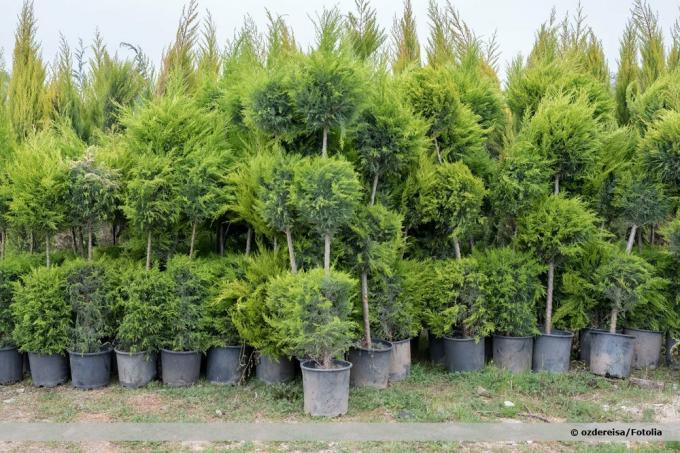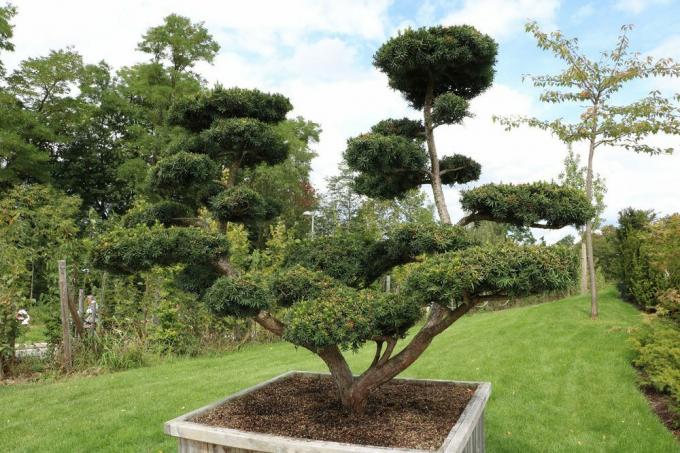
table of contents
- Conifers
- Conifers in the bucket
- Site conditions
- The right bucket
- Substrate
- Buy it or move it yourself?
- Planting time
- Repot
- to water
- Fertilize
- Cut
- Diseases & pests
- Overwinter
Conifers thrive in the garden soil, but there are many good reasons to put them in pots. This means that Thuja and Co. can give us pleasure even in the smallest of spaces. As mostly evergreen creatures, they remain decorative all year round and can be used flexibly in terms of design. However, cultivation in pots also requires more attention. They should never run out of water and nutrients and every conifer needs new housing or at least fresh soil every now and then.
Conifers
Everyone has an idea what a conifer is. Only a garden specialist will probably know which plants belong to the conifers, because there are many in number. The word conifer has its origin in the Latin language and means "cone bearer".
- also known as conifers
- species-rich and represented worldwide
- mostly evergreen
Note: In some conifer species the cones seem to be missing. Trees of life, for example, develop fruits that resemble round berries. But despite this look, they are actually cones.
Conifer species
Conifers have populated this earth for ages, some have accompanied the dinosaurs. Over time, many species could emerge that have developed peculiarities to match their living environment. Below are some conifers that we often encounter in this country:
- Araucaria
- yew
- Spruce
- jaw
- Tree of Life (Thuja)
- Umbrella fir
- juniper
- cypress
Note: Did you know that larch, which also belongs to the conifers, first turns its needles golden in autumn and then sheds them?

Conifers in the bucket
A young conifer, no matter what kind, gets along very well if it is only allowed to take root in one bucket. But what does it look like when the plant gets bigger and bigger over the years? You can decide which of the numerous conifer species is allowed to move into a bucket according to the following criteria:
- the size potential of a variety
- the available space for their bucket existence
- Appreciation of growth habit, crown, etc.
Small conifers are ideal to stay in a pot for a long time. Small thread cypress or small mussel cypress, spherical pine, dwarf juniper, sugar loaf spruce and dwarf arborvitae are some examples.
Site conditions
Whether left or right of the entrance, as a terrace border or balcony greening, many places are enhanced by a thuja in the bucket. But so that it can decorate the assigned location with its magnificent appearance, it must find ideal conditions there, as well as the other conifers. With a few exceptions, conifers prefer a sunny to partially shaded location. The dwarf tree and yew tree prefer to be in the shade. Some species cannot tolerate drafts.
tip: If you place the bucket on a mobile stand, you can easily move even large and heavy specimens to a new location.
The right bucket
This is not just about the question of taste, although this can of course also play a role. When it comes to the choice of materials, the manufacturers draw on a wealth of resources and offer us pots made of aluminum, concrete, terracotta, wood, ceramics, plastic and stainless steel, among other things. Each material has its own specific characteristics, which are useful or more likely to bother us, depending on what we are "planning" to do with the conifer. Here are a few pointers:
- Ceramic and earthenware not frost-proof
- Wood is natural and insulated
- Concrete is very heavy and unwieldy
- Plastic is not always UV-resistant
- Stainless steel is noble but also expensive
- Pot twice the size of the root ball
Does your conifer have to overwinter outside in freezing temperatures? Will you move the bucket more often? Which material allows the tree of life or another conifer to come into its own? If you have the answers to these questions ready when you buy, you will easily find the ideal pot specimen. However, it should always have sufficient drainage holes.
Substrate
If a plant has to get by with so little soil, it should at least be designed according to its ideas. The market thinks it knows these requirements very well and offers special conifer soil. These are their characteristics:
- Moisture is well stored
- permeable
- With a pH of 3.5 to 4.5, it is in the slightly acidic range
- rich in humus
- enriched with nutrients
tip: You are welcome to mix your own compost with the conifer soil when planting.
Buy it or move it yourself?
If you already have your own conifers, you can use them to gain new plants for your pots. The popular tree of life, for example, can be effortlessly passed through Cuttings multiply.
Otherwise, the garden market, whether online or on site, is abundantly stocked with conifers. You may have to look a little longer for a rare specimen, but you are sure to find it. Obviously, there are costs associated with acquiring them on the market, which are not necessary with your own propagation.

Planting time
In most people, the passion for gardening is kindled with the first rays of sunshine of the year. Then you want to beautify your home and garden for the coming outdoor season. Thuja, cypress and other coniferous plants are in demand as structuring agents and green backgrounds. Indeed, spring is a good time to plant conifers. Alternatively, autumn planting also offers good results.
Instructions for planting
Whether you prefer voluminous trees such as juniper or thuja, or you choose a different type of conifer, the planting process remains the same.
- Choose a pot that is twice the volume of the young conifer's root ball. It should offer enough leeway so as not to prematurely limit the upcoming growth.
- Place the container plant in the water so that the root ball soaks up with water. Only when no more bubbles rise is it ready for planting. If you have bought a bare-root conifer, it is enough to put it in the water for an hour.
- First fill the bucket with coarse material such as gravel, expanded clay or pottery shards. This approx. A 2 cm high drainage layer is important so that water does not build up.
- Cover the drainage layer with fleece.
- Put some of the conifer soil over it.
- Place the conifer in the middle of the pot.
- Hold the plant straight with one hand as you fill in any spaces with coniferous soil. Leave to the edge of the pot after approx. 5 cm free so that the soil is not washed out of the pot when watering later.
- Press the substrate and water it thoroughly.
Repot
Only in this text is the planting immediately followed by repotting, in practice you can take your time with this.
- Repot every 2 - 3 years
- or when growth / quality declines
- Use a larger pot and fresh soil
- Rule of thumb: per 120 cm tree height 30 cm diameter
- spring is ideal
- Caution: do not damage the roots
tip: The larger the pot, the more exposed earth surface is visible. You can also plant ground cover or plant different flower bulbs.
to water
The more limited a conifer is, the less it tolerates careless use of the watering can. After all, juniper, arborvitae and other conifers that you keep in pots cannot help but draw their roots from a limited supply. In addition, the soil dries out faster in a bucket at high temperatures. A dash of water is not the solution, because too much moisture is damaging to the health of the roots. Here are the watering rules:
- only water when the soil has dried up
- only water the earth, spare parts of plants above ground
- The water temperature should correspond to the ambient temperature
- Water in the morning or in the evening, never in the midday heat
- in hot weather mostly daily, otherwise approx. twice a week
- no water should remain in the coaster
- Water modestly even in winter on frost-free days
Fertilize
Every specimen that you keep in the bucket requires not only your admiration, but also regular feeding. These guarantee that the wood develops according to its intended purpose and does not show any deficiency symptoms. If, according to our recommendation, you used conifer soil for planting, the young plant is well cared for for the first 2-3 months. But then you have to replenish the nutrient depot.
- Apply liquid fertilizer every four weeks
- alternatively, use a slow release fertilizer 1-2 times a year
- The fertilization period is spring to August
tip: Since conifers prefer acidic soils, coffee grounds are an ideal natural fertilizer for them. It gives them numerous nutrients and at the same time lowers the pH of the earth.
Cut
No conifer needs the scissors to grow. But if we keep it in the pot, we are not satisfied with just growing it, we expect a beautiful, dense crown.
- Use scissors to shape it
- adhere to the species-specific recommendations
- Pay attention to balance / stability
- do not cut into old wood
- Fall and spring are ideal
- rather shorten it step by step than make radical cuts
- especially thuja and juniper are susceptible to cuts
- densely growing specimens can be shaped imaginatively

Diseases & pests
Diseases
Conifers are long-lived, but some fungal diseases can also weaken them in the bucket or end their lives prematurely. The list of possible diseases is long, for example root rot, rust fungus or thuja scale tan. It is important to optimally care for the tub specimens so that they develop a high level of resistance. Should you notice any abnormalities, such as stunted growth or Discoloration of the needles, investigate the cause immediately and take appropriate measures.
Pests
Leaf miners, spider mites, lice, all of them and much more, like to settle on the conifers. What has already been written about diseases applies here: Maintain plants in a species-appropriate manner and check for abnormalities. Only if you act promptly will the plant hardly be damaged.
Overwinter
Conifers can also stay outside in the tub in winter. Many owners are happy about this, because over time the plants get really big and heavy. Who has that much space to stow them away in winter? And who's in the mood for stressful relocation work? But it doesn’t work entirely without work! The pot cannot keep the icy cold away from the roots, as more comes through than the hardy conifers can handle.
- the more protected the location, the better
- Wrap the pot with fleece, jute or bubble wrap
- raised or put on styrofoam
- Protect the soil with leaves or straw
- Water sparingly only on frost-free days


